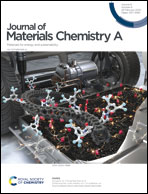Construction of an iron and oxygen co-doped nickel phosphide based on MOF derivatives for highly efficient and long-enduring water splitting†
Abstract
The exploitation of high catalytic activity electrocatalysts with abundant earth reserves is the prerequisite for extensive hydrogen production from water electrolysis. Herein, based on a feasible design idea, we fabricate an iron and oxygen co-doped nickel phosphide ((Fe0.1Ni0.9)2P(O)) by phosphating metal–organic framework (MOF) derivatives supported on nickel foam (NF) for efficient water splitting. In 1.0 M KOH, the (Fe0.1Ni0.9)2P(O)/NF electrode only requires an overpotential of 240 mV to reach 100 mA cm−2 for the OER and 87 mV to reach 10 mA cm−2 for the HER, respectively. Encouragingly, an alkaline electrolyzer assembled with the (Fe0.1Ni0.9)2P(O)/NF electrode can achieve a current density of 10 mA cm−2 at an extremely low voltage of 1.50 V, which is one of the lowest values currently achievable with non-precious metal electrocatalysts. Undoubtedly, this work provides a novel and practical strategy to synthesize highly efficient and durable electrocatalysts based on MOF derivatives for overall water splitting and other electrocatalysis.



 Please wait while we load your content...
Please wait while we load your content...